Just released this week. Available from Amazon stores around the world.

For UK the link is as follows:
https://amazon.co.uk/dp/B0C9SPDV2W
Available iin Kindle Book format as well.
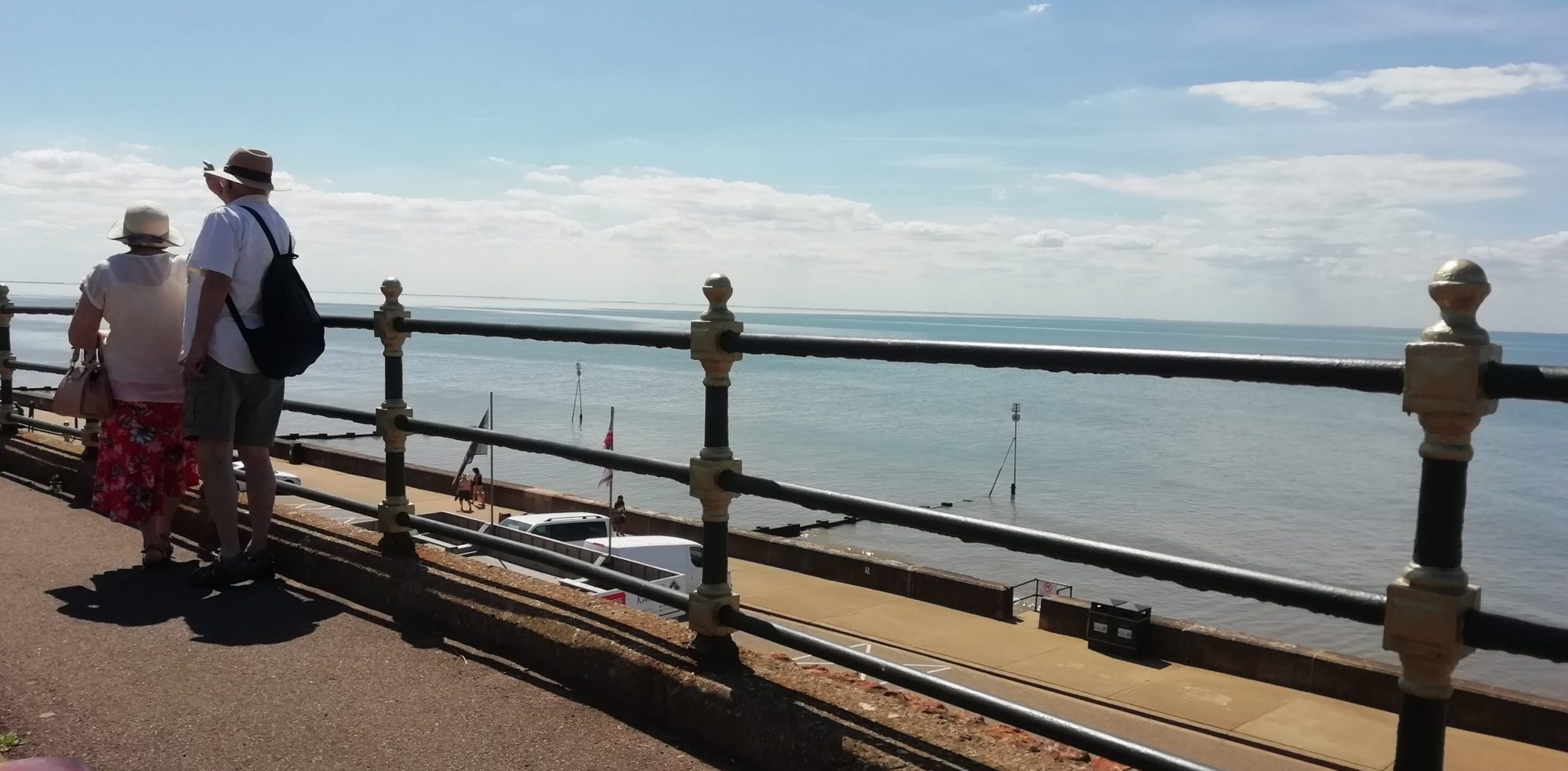
Blog and Published Pages
Just released this week. Available from Amazon stores around the world.

For UK the link is as follows:
https://amazon.co.uk/dp/B0C9SPDV2W
Available iin Kindle Book format as well.
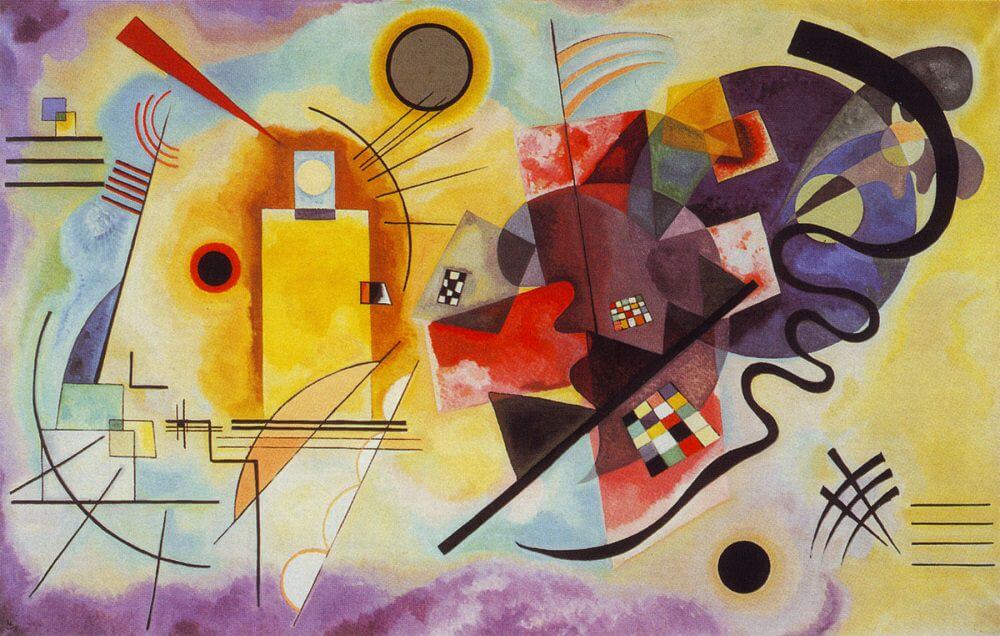
Walissy Kandinsky, Yellow, Red and Blue, oil on canvas (1925) Georges Pompidou Center, Paris,
Historical Context:
In the tumultuous landscape of early 20th-century Europe, Kandinsky emerged as a leading proponent of abstract art, advocating for the liberation of art from representational constraints. Influenced by movements such as Expressionism and Theosophy, Kandinsky developed a unique visual language characterized by dynamic shapes and intense colors, laying the groundwork for “Yellow, Red, Blue 1925.”
Formal Analysis:
“Yellow, Red Blue 1925” exemplifies Kandinsky’s mastery of form and color. The composition pulsates with geometric shapes and intersecting lines, creating a sense of rhythmic harmony. The juxtaposition of primary colors—yellow, red and blue—intensifies the painting’s emotional impact, inviting viewers into a realm of pure abstraction.
Symbolism and Meaning:
Central to Kandinsky’s artistic philosophy was the belief in the spiritual power of color and form. In “Yellow, Red, Blue 1925,” each hue carries symbolic significance: red evokes passion and vitality, yellow represents joy and enlightenment, and blue conveys depth and introspection. The dynamic interplay between these colors suggests a visual symphony, inviting viewers to contemplate the deeper essence of existence.
Critical Reception:
Art historians and critics have offered diverse interpretations of “Yellow, Red, Blue 1925.” Some view the painting as a celebration of pure abstraction, while others interpret it as a manifestation of Kandinsky’s synesthetic experiences. Regardless of the interpretation, scholars acknowledge its profound impact on the development of abstract art and its enduring relevance in contemporary discourse.
Influence and Legacy:
“Yellow, Red, Blue 1925” continues to inspire artists and viewers alike, serving as a touchstone for the exploration of color, form, and meaning. Its influence extends beyond the realm of visual art, permeating literature, music, and philosophy. As a testament to Kandinsky’s visionary genius, the painting remains a beacon of artistic innovation and creative expression.
Conclusion:
Through a synthesis of historical context, formal analysis, symbolism, critical reception, and influence, this literature review has illuminated the rich tapestry of interpretations surrounding Kandinsky’s “Yellow, Red, Blue 1925.” As we continue to unravel its mysteries and contemplate its significance, the painting stands as a testament to the transformative power of abstract art and the enduring legacy of one of the leading pioneers.
Nan Goldin, an American photographer renowned for her intimate and raw portrayal of human relationships, has left an indelible mark on contemporary art. Through her lens, she captures the complexities of love, pain, joy, and vulnerability with a haunting authenticity that resonates deeply with viewers. Let’s delve into the artistry of Nan Goldin, exploring some of her most iconic works and the profound impact they’ve had on the art world.
1. “The Ballad of Sexual Dependency”
Perhaps Goldin’s most famous body of work, “The Ballad of Sexual Dependency,” is a visual diary chronicling her life and the lives of her friends in New York City during the late 1970s and 1980s. Through gritty snapshots and candid portraits, Goldin captures moments of intimacy, ecstasy, and despair amidst the backdrop of a city plagued by the AIDS epidemic and social upheaval.
One of the defining features of Goldin’s work is her unflinching honesty. She doesn’t shy away from depicting the darker aspects of human existence, including drug addiction, domestic violence, and death. Yet, amidst the chaos and turmoil, there’s a sense of profound empathy that runs through her photographs, inviting viewers to connect with the subjects on a deeply emotional level.
2. “Nan and Brian in Bed”
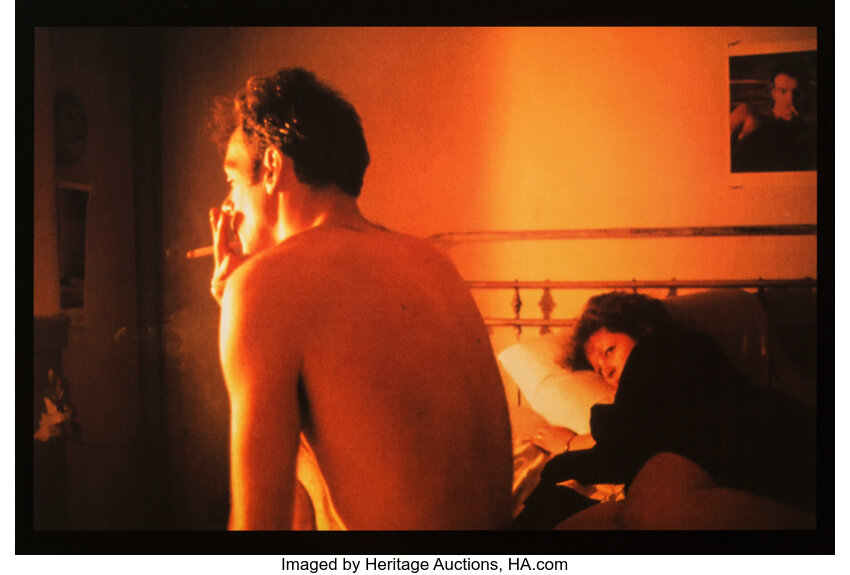
One of Goldin’s most iconic images, “Nan and Brian in Bed,” is a hauntingly intimate portrait of the artist and her then-partner, Brian, lying entwined in bed. The photograph exudes a sense of vulnerability and tenderness, capturing a moment of quiet intimacy between two lovers. Yet, there’s also an undercurrent of melancholy, hinting at the fragility of human connection and the fleeting nature of love.
3. “Misty and Jimmy Paulette in a Taxi, NYC”
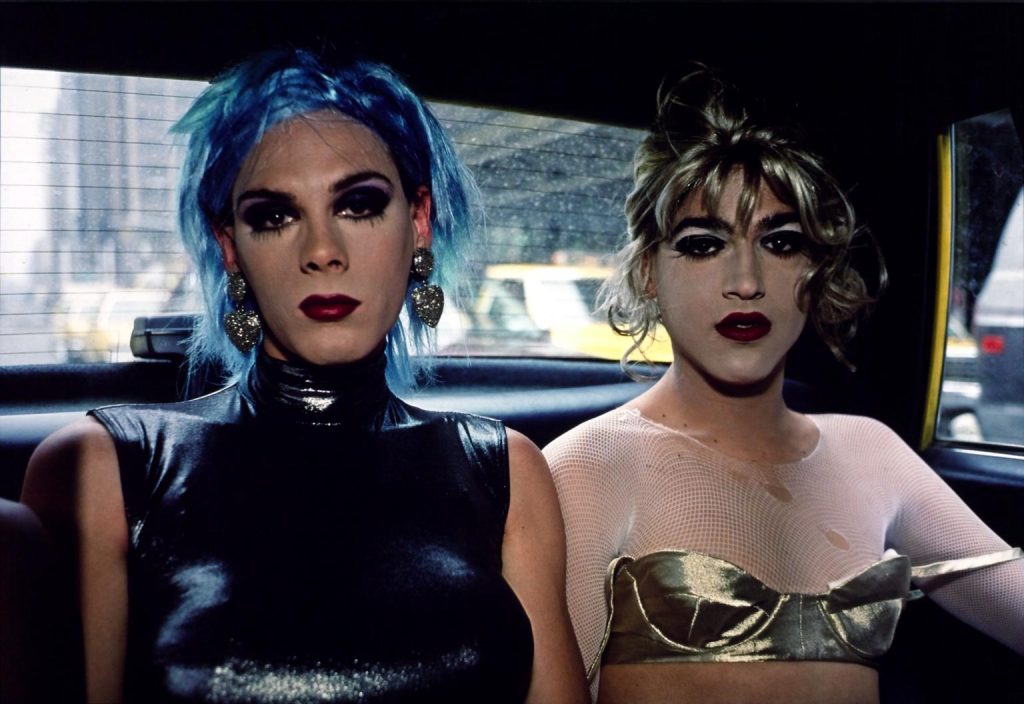
In this captivating photograph, Goldin immortalizes a fleeting moment shared between Misty and Jimmy Paulette, two of her close friends, as they ride in a taxi through the streets of New York City. The image is suffused with a sense of nostalgia, evoking the transient beauty of urban life and the bittersweet passage of time.
Goldin’s use of color and composition adds to the emotional resonance of the photograph, with the soft glow of streetlights casting a warm, ethereal hue over the scene. Through her lens, she captures not just the physical landscape of the city, but also the emotional landscapes of those who inhabit it, inviting viewers to contemplate the complexities of human experience.
4. “Self-Portrait in Kimono with Brian, NYC”
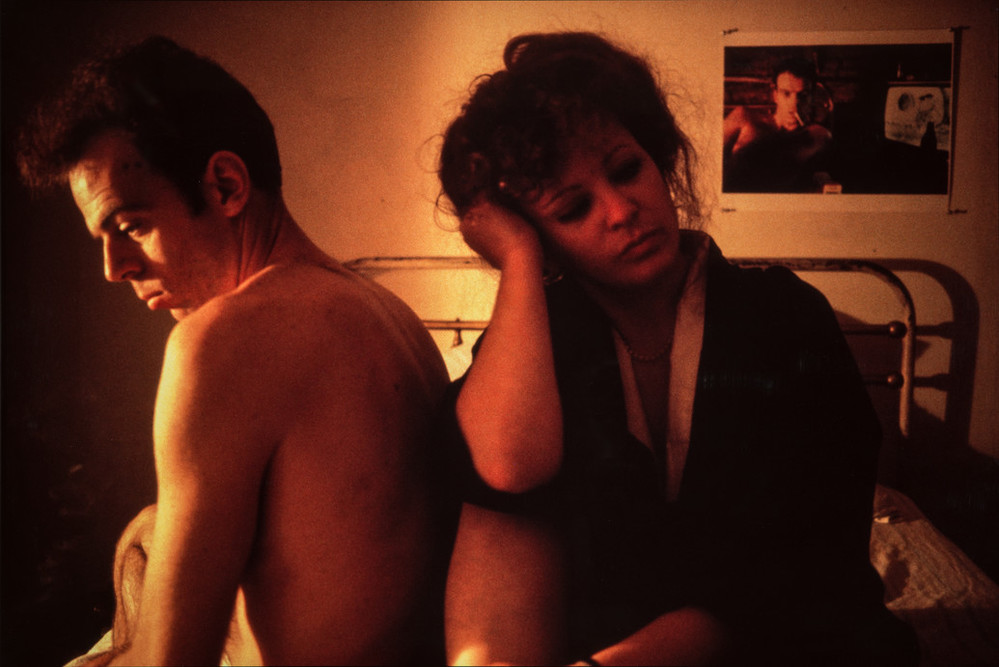
In this arresting self-portrait, Goldin presents herself adorned in a vibrant kimono, standing alongside her partner Brian. The image is a testament to Goldin’s fearless exploration of identity and self-expression, as well as her willingness to confront societal norms and expectations.
Through her art, Goldin challenges conventional notions of beauty and femininity, celebrating the diversity of human experience in all its forms. Her self-portraits, in particular, offer a glimpse into her own journey of self-discovery and self-acceptance, inviting viewers to reflect on their own perceptions of identity and belonging.
Conclusion
Nan Goldin’s art is a powerful testament to the beauty and complexity of the human experience. Through her raw and unfiltered portrayals of love, loss, and longing, she invites viewers to confront their own vulnerabilities and to embrace the full spectrum of human emotions. In a world often characterized by superficiality and pretense, Goldin’s work serves as a poignant reminder of the enduring power of authenticity and connection. As we gaze upon her photographs, we are reminded of our shared humanity and the universal desire for love, acceptance, and understanding.
Many news reports have appeared recently, suggesting watching illegal content (sports, films, etc., could result in criminal investigation and subsequent penalty if found guilty. The following investigates this premise!
The Fraud Act 2006 plays a role in controlling illegal streaming of copyright material by targeting the fraudulent behavior associated with such activities. While the act itself does not explicitly mention illegal streaming of copyrighted material, certain provisions within the act can be applied to combat this type of activity. Here’s how the Fraud Act 2006 assists in controlling illegal streaming of copyright material:
While the Fraud Act 2006 provides a legal framework to address fraudulent behavior associated with illegal streaming of copyright material, it is important to note that other laws and regulations, such as copyright laws and telecommunications regulations, also play a significant role in combating this type of activity. Enforcement agencies, rights holders, and internet service providers often work together to identify and take action against individuals and entities involved in illegal streaming operations, utilizing a combination of legal measures and technological solutions.
What about individual watching illegally streamed sports, etc?
The Fraud Act 2006 primarily addresses fraudulent behavior rather than the actions of individuals who may watch content for free through illegal means. Simply watching content for free, without actively engaging in fraudulent activities such as misrepresentation or deception, would not typically fall under the purview of the Fraud Act 2006.
Instead, the responsibility for enforcing laws related to copyright infringement generally falls on rights holders, law enforcement agencies, and internet service providers. Copyright laws establish the legal framework for protecting intellectual property, including audiovisual content, and provide avenues for rights holders to pursue legal action against those who engage in unauthorized distribution or consumption of copyrighted material.
In the context of illegal streaming, it is typically the individuals or entities who facilitate the unauthorized distribution of copyrighted content—such as operators of illegal streaming websites or services—that may be targeted under laws related to copyright infringement, rather than the individuals who passively consume the content.
However, it’s important to note that while simply watching content for free may not be considered a criminal offense under the Fraud Act 2006, it still constitutes copyright infringement and may carry civil penalties, including fines or injunctions, if pursued by rights holders. Additionally, internet users should be aware of the potential risks associated with accessing copyrighted material through unauthorized sources, such as exposure to malware, viruses, or other security threats.
Watching illegal content itself typically does not constitute a criminal offense. However, the act of accessing or streaming copyrighted material without proper authorization can be considered copyright infringement, which is a civil offense rather than a criminal one.
In most jurisdictions, copyright infringement occurs when someone reproduces, distributes, performs, or displays copyrighted material without permission from the copyright owner. This includes downloading or streaming movies, music, TV shows, or other content from unauthorized sources such as torrent sites, illegal streaming platforms, or file-sharing networks.
While watching illegal content may not directly violate copyright laws, the act of accessing or streaming copyrighted material without authorization indirectly supports the dissemination of pirated content, contributing to the infringement of intellectual property rights. As a result, individuals who knowingly access or stream copyrighted material from unauthorized sources may be subject to legal action by rights holders, such as civil lawsuits seeking damages for copyright infringement.
It’s important for individuals to be aware of the legal implications of accessing copyrighted material from unauthorized sources and to seek legitimate means of accessing content, such as through licensed streaming services, rental platforms, or purchasing content from authorized distributors.

Madame Pompadour, 1914, oil on on canvas, Art Institute of Chicago, Chicago, IL, US
Abstract: Amedeo Modigliani, an Italian artist of the early 20th century, remains a towering figure in the annals of modern art. His distinctive style, characterized by elongated figures, simplified forms, and a sense of timeless elegance, has captivated art enthusiasts and scholars alike. This paper explores Modigliani’s life, artistic influences, and enduring legacy, examining the unique contributions he made to the modernist movement.
The Modigliani Style: One of the most striking aspects of Modigliani’s art is his distinctive style, characterized by elongated figures, almond-shaped eyes, and sensuous curves. His portraits, rendered with a bold simplicity and a keen sense of line, exude a timeless elegance and emotional depth. Modigliani’s use of color, often muted and subtle, adds to the enigmatic allure of his compositions.
Portraiture and the Human Psyche: Central to Modigliani’s oeuvre is his fascination with the human face and form. His portraits, whether of friends, lovers, or anonymous sitters, offer glimpses into the inner lives of his subjects. Through subtle gestures and expressions, Modigliani captures the essence of his sitters, revealing their vulnerabilities, desires, and complexities.

Reclining Nude 1919. Museum of Modern Art, New York
Legacy and Influence: Although Modigliani’s career was cut short by his untimely death at the age of 35, his impact on the art world was profound and enduring. His influence can be seen in the works of later artists, from figurative painters to abstract expressionists. Modigliani’s ability to distill the essence of the human experience into timeless works of art ensures his place among the pantheon of modernist visionaries.
Conclusion: Amedeo Modigliani’s legacy endures as a testament to the power of artistic vision and creative expression. Through his distinctive style and evocative portraits, he captured the spirit of a tumultuous era while transcending the boundaries of time and place. As we continue to study and appreciate his art, we are reminded of the enduring power of beauty, empathy, and the human spirit.
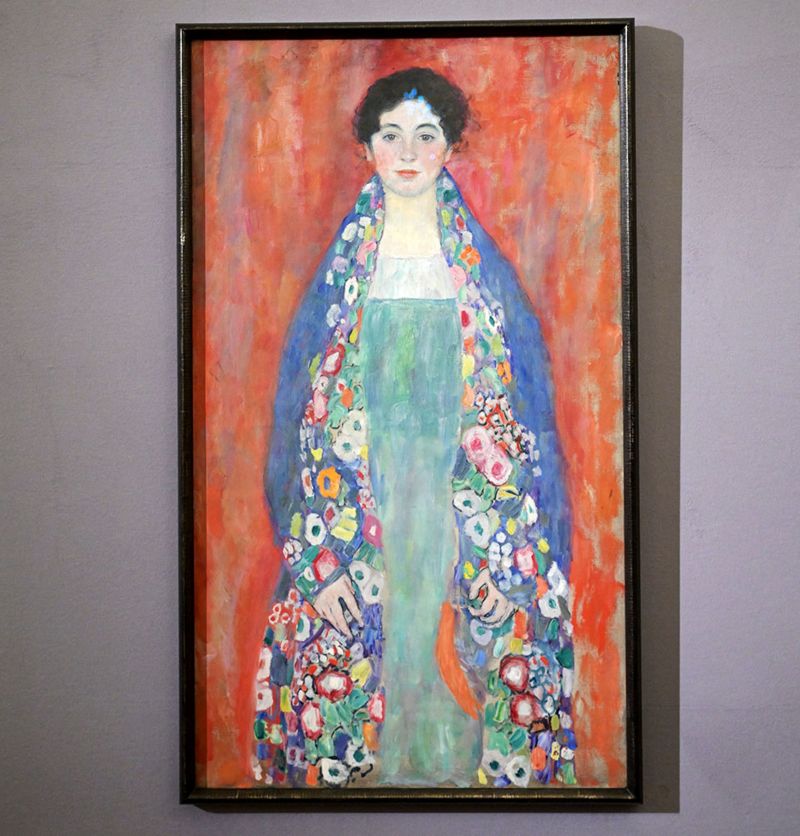
In a remarkable twist of fate, a long-lost painting by the iconic Austrian artist Gustav Klimt has been rediscovered after more than a century. The painting, ‘Portrait of Fraulein Lieser’, found in Vienna, has reignited interest in Klimt’s extraordinary body of work.
Gustav Klimt, known for his distinctive style characterized by intricate patterns, vibrant colors, and sensual themes, was a leading figure of the Vienna Secession movement in the late 19th and early 20th centuries. His works, celebrated for their symbolism and decorative allure, have captivated audiences around the world for generations.
The rediscovery of this lost masterpiece adds another chapter to Klimt’s legacy and offers art enthusiasts a rare opportunity to witness a previously unseen creation by the maestro himself. Scholars and experts are eagerly studying the painting to authenticate its provenance and unravel the mysteries surrounding its disappearance and reappearance.
The significance of this discovery extends beyond the art world, offering a glimpse into the cultural heritage and history of the era in which Klimt lived and worked. The painting’s journey from obscurity to rediscovery serves as a reminder of the enduring allure of art and the stories it carries through time.
As the world celebrates the rediscovery of this long-lost Klimt painting, it serves as a poignant reminder of the enduring legacy of one of the most influential artists of the modern era. With each stroke of his brush, Klimt left an indelible mark on the art world, and this rediscovered masterpiece is yet another testament to his enduring genius.

Introduction: Nestled in the heart of Florence, Italy, the Florence Cathedral, also known as the Cathedral of Santa Maria del Fiore, stands as a testament to the city’s rich history, architectural prowess, and artistic splendor. In this post, we’ll explore the magnificence of the cathedral, its iconic artworks, and practical details for planning an enriching visit.
History and Architecture: Built over several centuries, with construction commencing in 1296, the Florence Cathedral is a masterpiece of Gothic and Renaissance architecture. Its stunning dome, designed by Filippo Brunelleschi, is an engineering marvel and remains the largest brick dome ever constructed. The intricate façade, adorned with polychrome marble panels, showcases the craftsmanship of generations.
Artistic Treasures Inside: 1. The Last Judgment by Giorgio Vasari:

Ceiling Mural, Georgio Vasari, 1572 and completed by Zuccari 1579
Adorning the interior of the dome, this fresco depicts the final judgment and is a testament to Vasari’s mastery of composition and storytelling.
2. The Baptistry Doors (Gates of Paradise) by Lorenzo Ghiberti:

Baptistry showing Ghiberti’s doors (copies). Originals in museum.
Located on the Baptistery adjacent to the cathedral, these bronze doors are a Renaissance masterpiece, showcasing scenes from the Old Testament with exquisite detail.
3. The Duomo Museum:

Michelangelo’s Deposition (incorrectly known as the Florence Pieta)
Housing original sculptures from the cathedral, the museum offers insights into the art and history of the Florence Cathedral. Visitors can marvel at Michelangelo’s unfinished Pietà and other precious artifacts.
Opening Times:
Planning Your Visit: To make the most of your visit to the Florence Cathedral, consider purchasing a combined ticket that grants access to the cathedral, dome, baptistery, and museum. Be mindful of dress codes, as visitors are expected to dress modestly when entering religious sites. Climbing to the top of the dome provides not only panoramic views of Florence but also a close-up look at the magnificent frescoes.
Experiencing Florence’s Cathedral: Wandering through the grandeur of the Florence Cathedral is a journey through time and artistic innovation. As you marvel at the architectural details, gaze upon masterpieces, and absorb the ambiance of this sacred space, you’ll find yourself immersed in the rich cultural tapestry of Florence. Advance tickets are recommended. Queues can be long especially in summer months and at weekends.
Conclusion: The Florence Cathedral stands as a beacon of art, culture, and spirituality. From its awe-inspiring architecture to the masterpieces housed within, a visit to this iconic landmark promises an enriching experience for art enthusiasts and history lovers alike. Plan your visit thoughtfully, and let the Florence Cathedral unfold its tales of centuries past before your eyes.

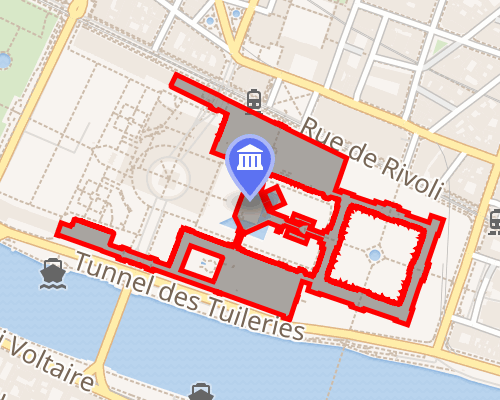
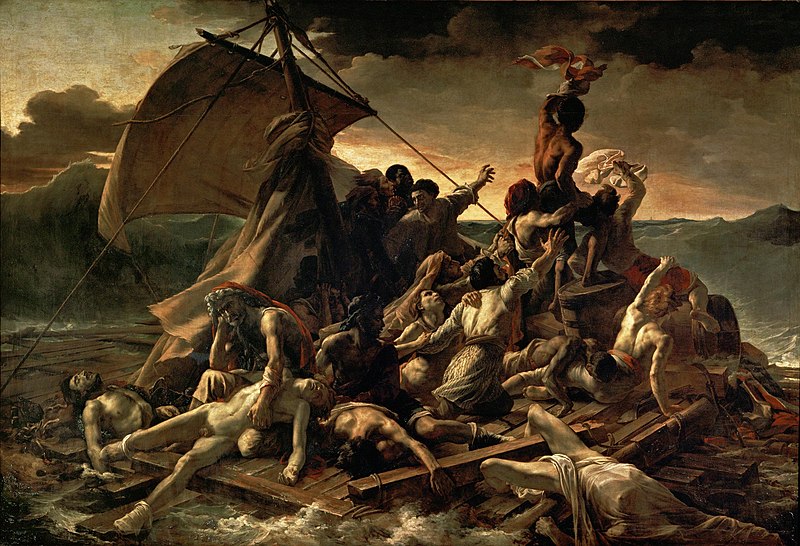
The Raft of the Medusa, Géricault, 1818-1819, Oil on canvas, Louvre, Paris
“The Raft of the Medusa,” painted by Théodore Géricault in 1818-1819, is a monumental work that stands as a seminal example of history painting in France during the 19th century. Géricault’s masterpiece captures a tragic episode from French naval history, the wreck of the frigate Medusa, and epitomizes the Romantic movement’s emphasis on emotional intensity and social commentary.
Historical Context: The painting depicts the aftermath of the wreck of the Medusa off the coast of Senegal in 1816, where survivors were left adrift on a makeshift raft. Géricault, influenced by a sensationalized firsthand account, chose to portray the human suffering, desperation, and survival instincts of those stranded at sea for thirteen days.
Romanticism and Emotional Impact: As a history painting, “The Raft of the Medusa” aligns with the Romantic movement’s rejection of classical ideals and emphasis on emotion and individual experience. Géricault’s composition is monumental and dramatic, capturing the raw intensity of the human struggle for survival. The painting’s scale and emotional power serve as a testament to the Romantic belief in art’s ability to evoke strong emotions and societal reflection.
Political and Social Commentary: Beyond its dramatic depiction of a maritime disaster, Géricault’s painting also carries a socio-political message. The Medusa incident was marred by incompetence and political corruption, and Géricault used his art to critique these failings. The painting serves as a powerful indictment of the French government’s negligence and highlights broader themes of human suffering and resilience in the face of systemic failures.
Composition and Realism: Géricault’s attention to detail and commitment to realism contribute to the impact of the painting. The carefully rendered expressions, the depiction of the human form, and the stark contrasts of light and shadow all enhance the sense of immediacy and authenticity. The composition, with its pyramidal structure and central focus on a figure waving for rescue, draws the viewer into the heart-wrenching narrative.
Legacy and Influence: “The Raft of the Medusa” has left an enduring mark on the history of art. It exemplifies the shift towards realism and social commentary in history painting and has influenced subsequent generations of artists. Géricault’s bold departure from traditional representations of historical events paved the way for a more nuanced and critical approach to storytelling through visual art.
In conclusion, Géricault’s “The Raft of the Medusa” not only encapsulates the tragic events of the Medusa shipwreck but also exemplifies the evolution of history painting in France during the 19th century. Its emotional power, political undertones, and commitment to realism make it a landmark work that continues to resonate with audiences today.
Caravaggio, the iconic Baroque artist of the late 16th and early 17th centuries, left an indelible mark on the art world through his revolutionary use of chiaroscuro.

| ArtistCaravaggioYear1599–1600MediumOil on canvasDimensions322 cm × 340 cm (127 in × 130 in)LocationSan Luigi dei Francesi, Rome |
|---|
Chiaroscuro, derived from the Italian words “chiaro” (light) and “scuro” (dark), refers to the technique of juxtaposing light and shadow to create a dramatic and heightened sense of realism in art. Caravaggio’s works are exemplary in their mastery of chiaroscuro, transforming ordinary scenes into compelling narratives through the manipulation of light and shadow.

| Artist | Caravaggio |
|---|---|
| Year | c. 1598–1599 or 1602 |
| Medium | Oil on canvas |
| Dimensions | 145 cm × 195 cm (57 in × 77 in) |
| Location | Galleria Nazionale d’Arte Antica at Palazzo Barberini, Rome |
One of Caravaggio’s defining characteristics is his bold and innovative approach to lighting. In his masterpiece, “The Calling of Saint Matthew,” he skillfully employs chiaroscuro to cast an ethereal light that dramatically illuminates the central figures while plunging the background into deep shadow. This stark contrast not only emphasizes the divine moment of Matthew’s calling but also creates a profound emotional impact on the viewer.
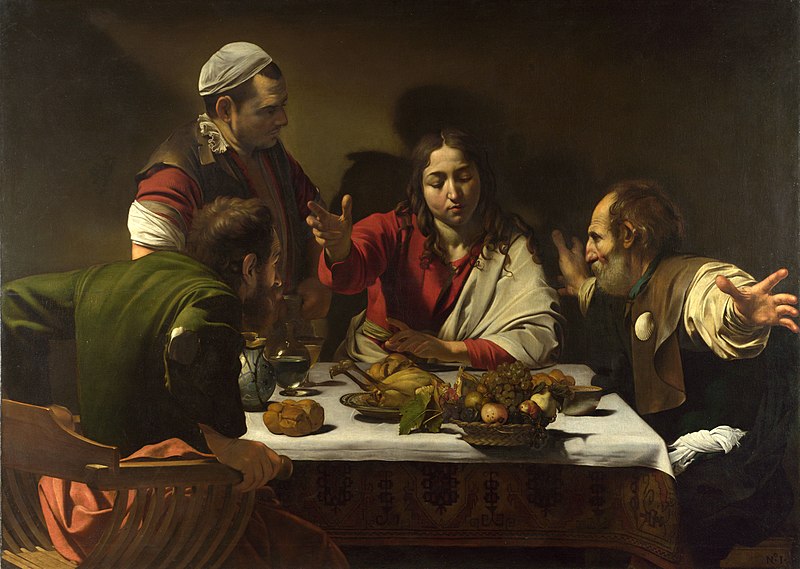
| Artist | Caravaggio |
|---|---|
| Year | 1601 |
| Medium | Oil on canvas |
| Dimensions | 141 cm × 196.2 cm (56 in × 77.2 in) |
| Location | National Gallery, London |
Caravaggio’s use of chiaroscuro goes beyond mere technical prowess; it becomes a narrative device. In “Judith Beheading Holofernes,” the intense light falling on Judith’s face and the gleaming sword creates a focal point, heightening the tension and brutality of the scene. The surrounding darkness amplifies the psychological drama, drawing the viewer into the harrowing act.
The chiaroscuro technique becomes a powerful tool for Caravaggio to convey the play of emotions on his subjects’ faces. In “The Supper at Emmaus,” the radiant light falling on the resurrected Christ’s face and the shocked expressions of his disciples capture the profound moment of recognition. Caravaggio’s ability to use light and shadow as emotive elements enhances the psychological depth of his characters, making them relatable and engaging.
Caravaggio’s chiaroscuro technique extends beyond religious themes to his genre paintings, such as “The Cardsharps.” Here, the masterful interplay of light and shadow becomes a visual metaphor for the moral ambiguity of the scene. The stark illumination on the young cheat’s face contrasts with the shadowy backdrop, emphasizing the deceptive nature of the game.

| ArtistCaravaggioYearc. 1594MediumOil on canvasDimensions94 cm × 131 cm (37 in × 52 in)LocationKimbell Art Museum, Fort Worth |
|---|
In conclusion, Caravaggio’s contribution to art, particularly through his groundbreaking use of chiaroscuro, remains unparalleled. His ability to infuse ordinary scenes with extraordinary drama and emotion elevates his works to timeless masterpieces. Through the manipulation of light and shadow, Caravaggio not only created visually stunning compositions but also pioneered a new way of storytelling in art, leaving an enduring legacy that continues to inspire and captivate audiences centuries later.
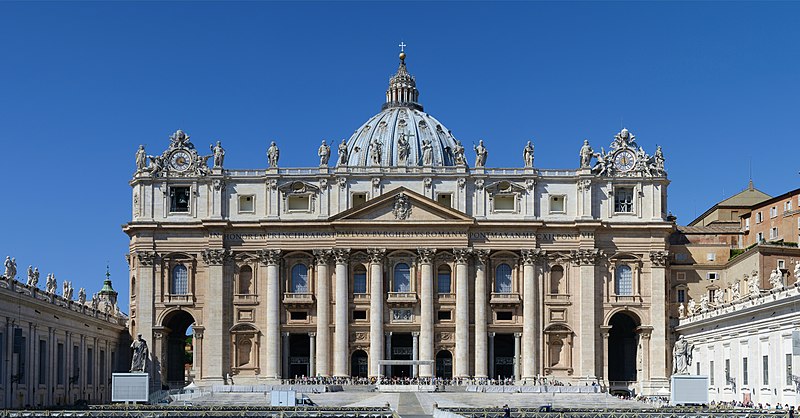
Facade and Dome of St Peter’s Basilica, Rome in Italy
The architecture of St. Peter’s Basilica in Rome is predominantly Renaissance and Baroque in style. Designed by architects like Donato Bramante, Michelangelo, Carlo Maderno, and Gian Lorenzo Bernini, it showcases a harmonious blend of classical and innovative elements. The basilica’s iconic dome, designed by Michelangelo, is a testament to Renaissance aesthetics, while Bernini’s grandiose colonnade and the baldachin inside represent Baroque opulence. The overall design reflects a synthesis of artistic vision and religious symbolism, making St. Peter’s one of the most significant architectural achievements in history.
St. Peter’s Basilica in Rome was built over several centuries, with construction spanning from the early 16th century to the 17th century. Here is a brief overview of the key phases:
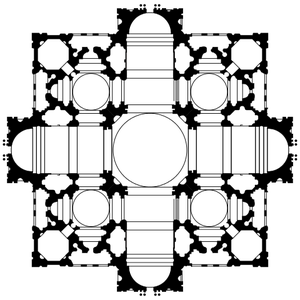
Bramante’s design for St Peter’s
Early Planning (1506-1514): Pope Julius II initiated the project and commissioned architect Donato Bramante to design a new basilica to replace the old St. Peter’s. Bramante’s plans included a centralized Greek-cross plan with a majestic dome.
Michelangelo’s Influence (1514-1547): After Bramante’s death, Michelangelo took over as the chief architect. He modified Bramante’s plans, particularly emphasizing the dome. Michelangelo’s architectural vision left an indelible mark on the basilica, with his dome becoming one of its most iconic features.
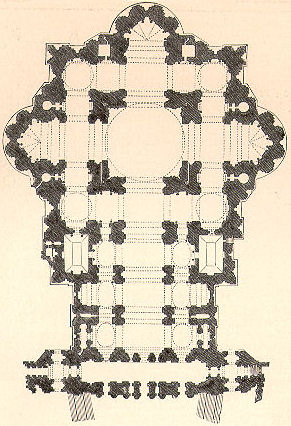
Maderno’s extention
Carlo Maderno’s Extensions (1607-1612): Carlo Maderno, the next architect in line, extended the nave, creating a Latin-cross plan. He also designed the impressive façade, which added a sense of grandeur to the exterior of St. Peter’s. It is also criticised for its obscuration of Michaelangelo’s Dome.

Bernini’s Baldachin within St Peter’s Basilica
Gian Lorenzo Bernini’s Contributions (1626-1667): Bernini played a crucial role in the final stages. He designed the monumental bronze baldachin over the high altar and the vast piazza with its embracing colonnade, creating a sense of unity between the church and the square.
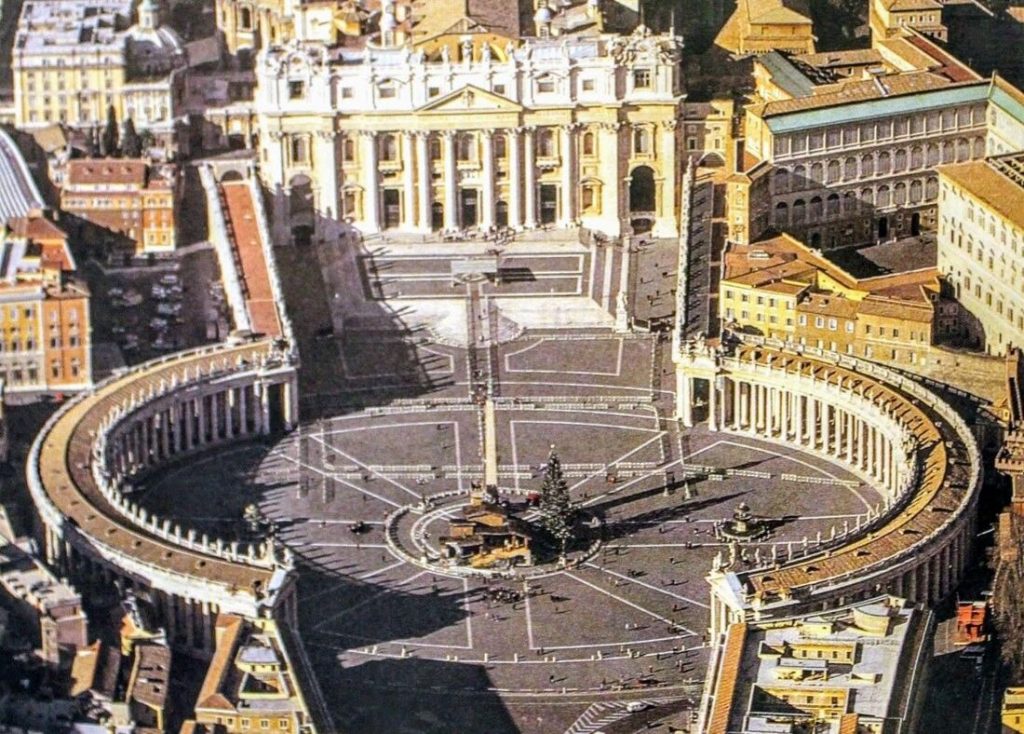
View of Bramante’s Colonnade
Throughout the construction, various architects and popes contributed to St. Peter’s Basilica, resulting in a masterpiece that combines Renaissance and Baroque elements. The basilica stands as a symbol of both religious devotion and architectural brilliance.